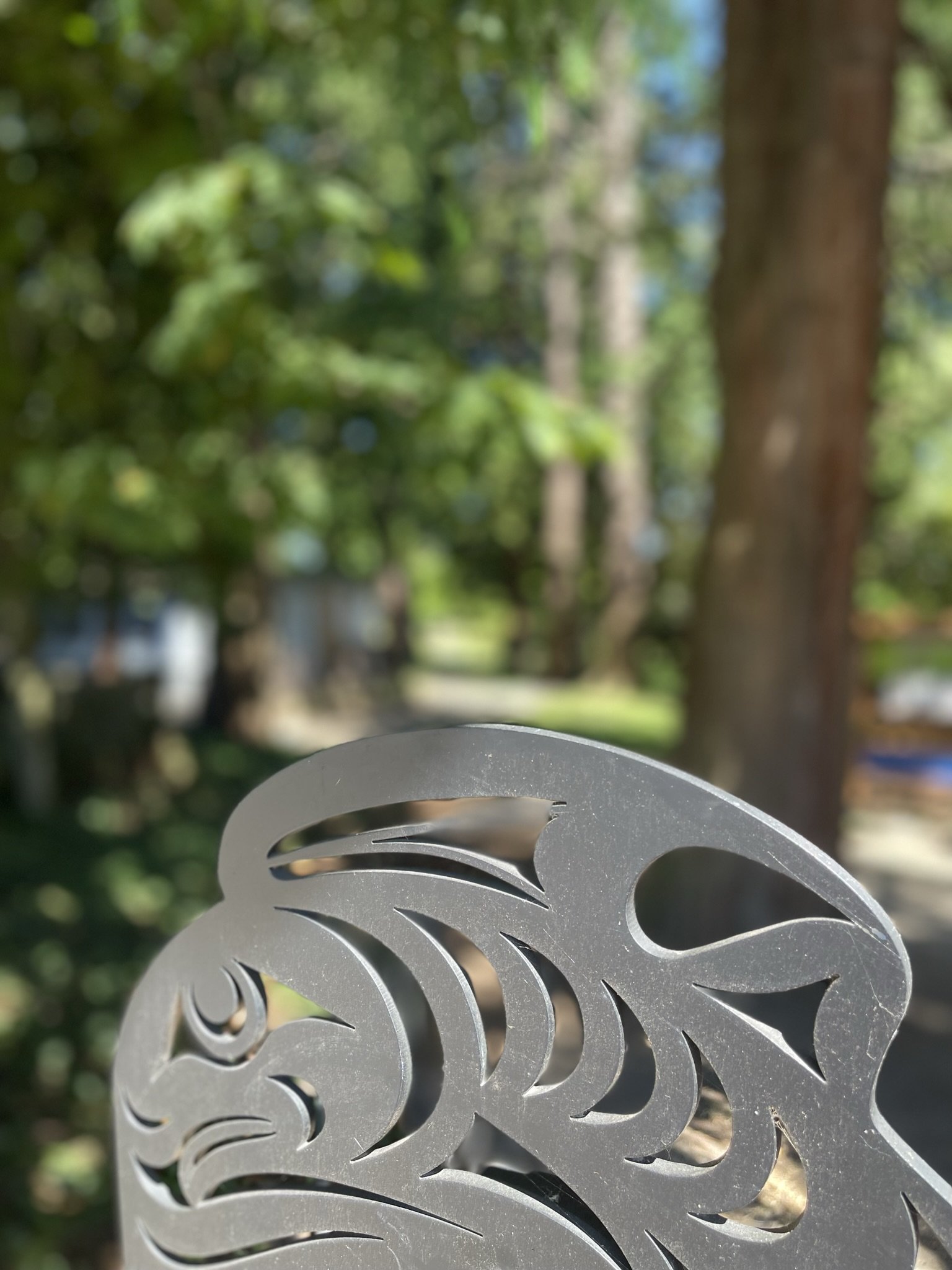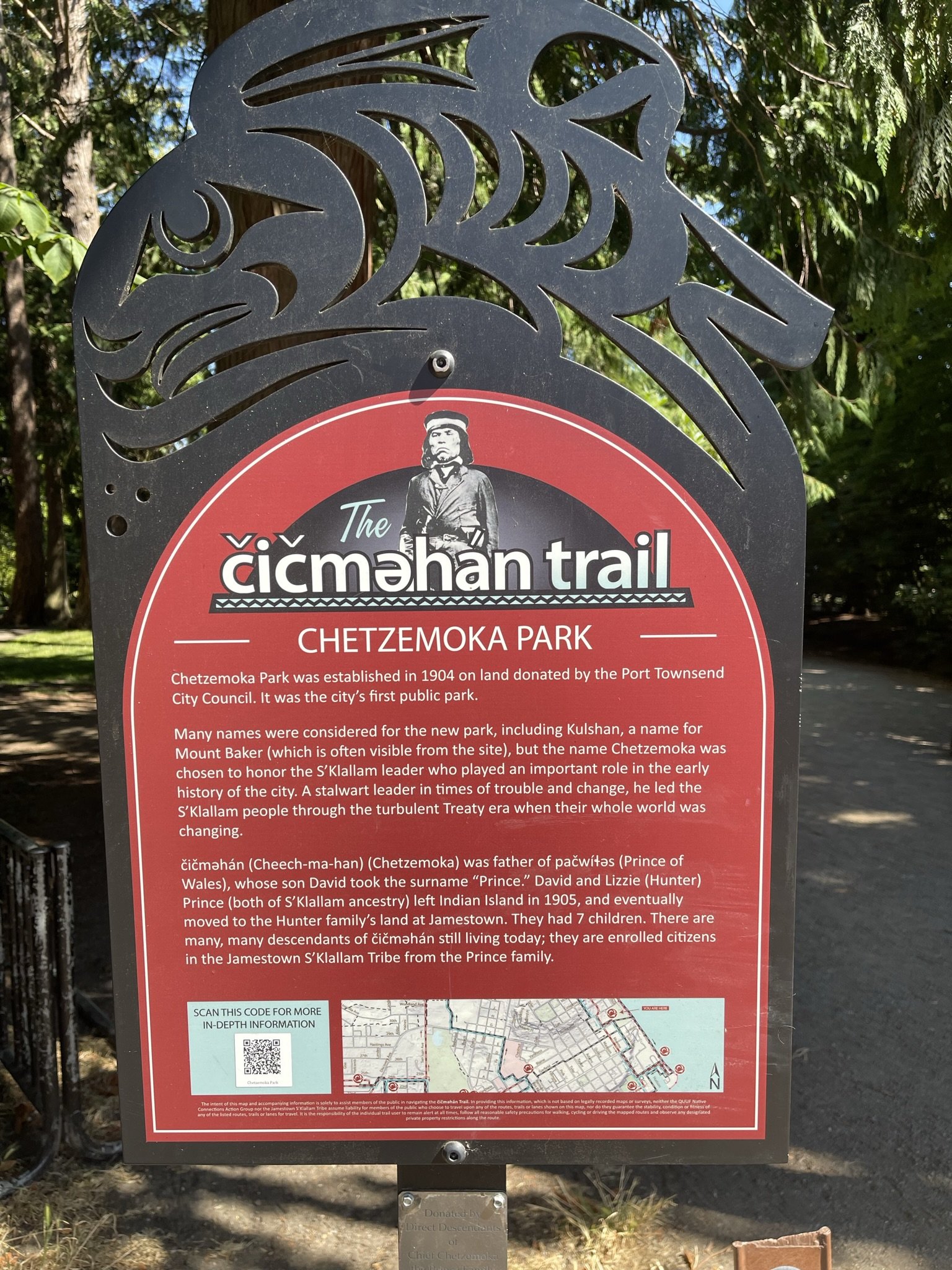Elaine Grinnell: Jamestown S’klallam Tribal Storyteller & Singer
It began in frightening times for young Elaine. She sat near a potbelly stove with her grandfather, David Prince, during World War II blackouts along the Jamestown Beach. But as he calmly peeled apples and told stories, Elaine listened, her fears forgotten as she pressed each word into her mind. He gave her the gift of storytelling. Today, this art medium overlaps with traditional cooking and basketry for Elaine.
She spent much of her life living around the Straights of Juan de Fuca (also known as the Salish Sea) where she digs clams, picks oysters, catches salmon, crab and octopus and prepares them in traditional ways. “I have taught two generations of my family to do the same and am beginning to teach our third generation,” Elaine says. She is also showing them how to gather, prepare, and weave Western Red Cedar bark along with their stories.
Because of that dedication, Khia Grinnell (Jamestown S’Klallam and Lummi) nominated Elaine for the CSA. “My grandmother has worked tirelessly to preserve and share our culture,” Khia says. “She has served as an ambassador of our people in a manner that has made not only her family but her community proud.”
Following in the steps of her grandmother Elaine, Khia is a storyteller and serves on the Northwest Native American Basketweavers Association board alongside Elaine.
Elaine also serves on the Jamestown S’Klallam Culture Committee, the Native Elders Committee of the University of Washington, Northwest Native American Storytellers Association board, and is a certified Klallam language teacher. (From the firstpeoplesfund.org)
Timeline of Jamestown S'Klallam History
The ancestral territory of S’Klallams stretched across the Olympic Peninsula from the Hoko River to the east side of Discovery Bay into Port Townsend Bay including Indian Island, Marrowstone Island, Oak Bay, and Whidbey Island. Also on Vancouver Island, BC is the S’Klallam village Beacher Bay.
1828: A S’Klallam village is burned in Port Townsend by the Hudson Bay Company.
1855: S’Klallams sign the Treaty of Point No Point. Chief čičmǝhán (Chetzemoka) was one of the signers. The S’Klallams agreed to give up millions of acres of land in exchange for payment of $60,000 over 20 years and the right to fish and hunt in their “usual and accustomed places”.
1856: A second S’Klallam village burned.
1859: Population of S’Klallams in Port Townsend is 200, likely due to disease.
1860: James Swan census of Indian camp at Point Hudson noted 14 S’Klallam lodges.
1862: Census notes 1,300 S’Klallams in Port Townsend area.
1871: Port Townsend passes a city ordinance that prohibited Indigenous dwellings. The last know S’Klallam village in Port Townsend is burned.
1874: S’Klallams purchase 210 acres of their own ancestral land in what is known as Sequim-Dungeness area today. The settlement area was names after Tuls-mee-tum (English name Lord James Balch), the local S’Klallam leader who led the effort of the land purchase. The last potlatch held was in 1878.
1878: Census notes 598 S’Klallam in the Port Townsend area.
1885: Shaker Church was established at Jamestown (Sequim).
1887: The Dawes Act is passed, dividing communally held tribal lands into separate parcels, allowing them to be authorized for sale to non-natives.
1888: Chief Chetzemoka passes away.
1893: Port Townsend builds a post office with four Romanesque columns flanking the entrance. Carvings on the columns honor Chief Chetzemoka, his two wives, and his brother.
1904: Port Townsend establishes Chetzemoka Park.
1920’s: S’Klallams form a Tribal Council which included all three S’Klallam “bands” (before they became three separate tribes).
1936: Jamestown forms its own Tribal Council.
1977: W. Ron Allen becomes Chair of the Jamestown S’Klallam Tribe.
1981: Jamestown receives federal recognition by the federal government. This process took about 15 years to complete.
1987: Jamestown first community center is built.
1988: Jamestown opens its first Tribal Center Building (now known as the Administrative Building).
1995: Jamestown opens 7 Cedars Casino, a first major economic enterprise for the Tribe.
1996: Port Townsend dedicates a statue of Chief Chetzemoka to make Sentinel Rock, a high point on the bluff. This was to mark the moment when the Chief was to signal whether a war would break out between the S’Klallams and non-native settlers. The Chief advocated for peace between the parties.
2018: Jamestown, Port Gamble, and Lower Elwha ramp up tribal presence and participation in Jefferson County and City of Port Townsend. Participation includes Indigenous People’s Day, and various welcomings at events. Our participation continues currently.
2019: This was a big year! The čičmǝhán Trail was completed and then dedicated with a large celebration. In addition, the Jamestown Tribe gifted a 26-foot totem pole to Port Townsend and was installed outside the Maritime Center. Best of all, Mayor Deborah Stinson announced that the Port Townsend City Council enthusiastically repealed the 1871 ordinance against Indigenous dwellings in Port Townsend. This was repealed on June 10, 2019. Jamestown also begins cultural sensitivity training with Port Townsend entities such as the School District and the Quimper Unitarian Universalist Fellowship. Jamestown and Port Gamble participate in Jefferson County Historical Society First Friday Lectures.
2020-2021: In-person tribal participation in Jefferson County is paused due to COVID. However, Indigenous People’s Day Proclamations continued each year through virtual meetings.
2022: Jamestown and the Port Townsend School District sign a Memorandum of Understanding that details how the two parties will partner together to serve Native students in the district, with the goal of increasing academic success.




